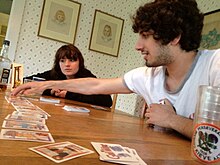Guillotine (game)

A group of executioners playing Guillotine
|
|
| Designer(s) | Paul Peterson |
|---|---|
| Illustrator(s) | Quinton Hoover Mike Raabe |
| Publisher(s) |
AMIGO Spiel + Freizeit GmbH Darwin Project Hasbro Play Factory PS-Games Wizards of the Coast |
| Players | 2 to 5 |
| Age range | 12 years and up |
| Playing time | 30 minutes |
Guillotine is a card game created by Wizards of the Coast and designed by Paul Peterson. The game is set during the French Revolution, and was released on Bastille Day in 1998. The goal is to collect the heads of Nobles, accumulating points. Despite the grim topic of the game, the artwork is comical and the tone light.
Guillotine won the 1998 Origins Award for Best Traditional Card Game.
Game play, for two to five players, takes approximately 30 minutes. Game equipment consists of two decks of cards, "Nobles" and "Actions", and a small cardboard structure representing the guillotine itself. This is mostly symbolic, though it can serve as a convenient indicator of the direction of the "line" of face-up Noble cards played on the game table representing condemned persons waiting to be beheaded. The Nobles cards carry points values and are collected by players after execution, while Action cards allow the player to perform various acts including rearranging the order of Nobles approaching the guillotine, stealing Nobles or Action cards from other players, enhancing the point values of certain categories of Nobles (see "Noble Types" below) and so forth.
The game is divided into three rounds or "days". Each day, twelve noble cards are dealt face-up in a row to be executed. A player's turn consists of:
The Nobles come in five categories, each with its own color border:
Grey nobles, typically martyrs that have public sympathy, are worth negative points so the player's goal is to avoid collecting them if possible. Palace guards, in the red category, have a special value in that each guard is worth the total number of guards collected. Thus one guard is worth one point, two guards are worth four points, three guards are worth nine points and so forth. The other Nobles have values ranging from 1 to 5 points.
A typical turn example is a player using an Action card to move a Noble two places forward in the line, i.e. advance a high-point Noble from third position to first, collecting that Noble, then drawing another Action card to end the turn. Other Action cards allow the player to move a Noble one or more places backward, useful for moving a low- or negative-value card off the front of the line to collect a higher-value second-position Noble.
Certain Noble cards affect the game, including a "Fast Noble" requiring the player who collects it to also take the next Noble in line. A card symbolizing Maximilien Robespierre (beheaded in 1794) causes the "day" to instantly end upon his decapitation. At the end of a "day" of gameplay (either by the collection of the Robespierre card or the exhaustion of the line), a new line of Nobles is dealt face-up and play resumes. After three "days", the player with the highest point total wins.
...
Wikipedia
